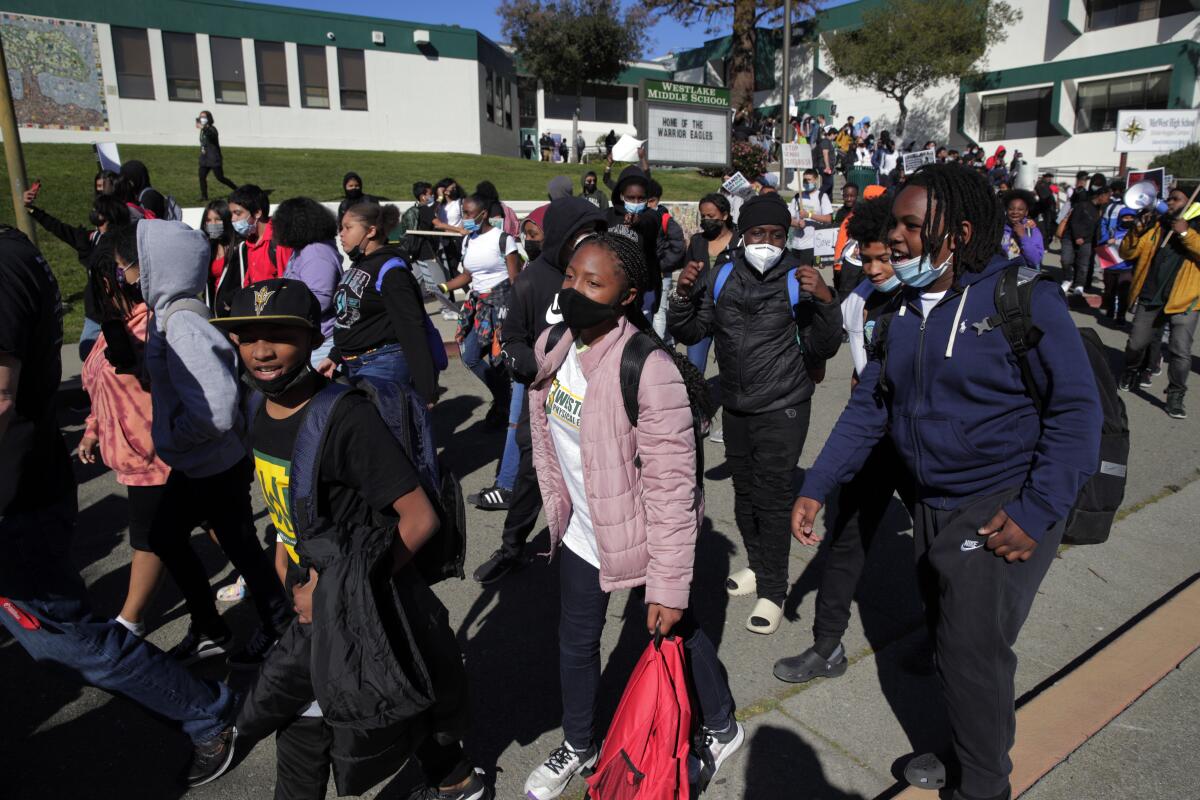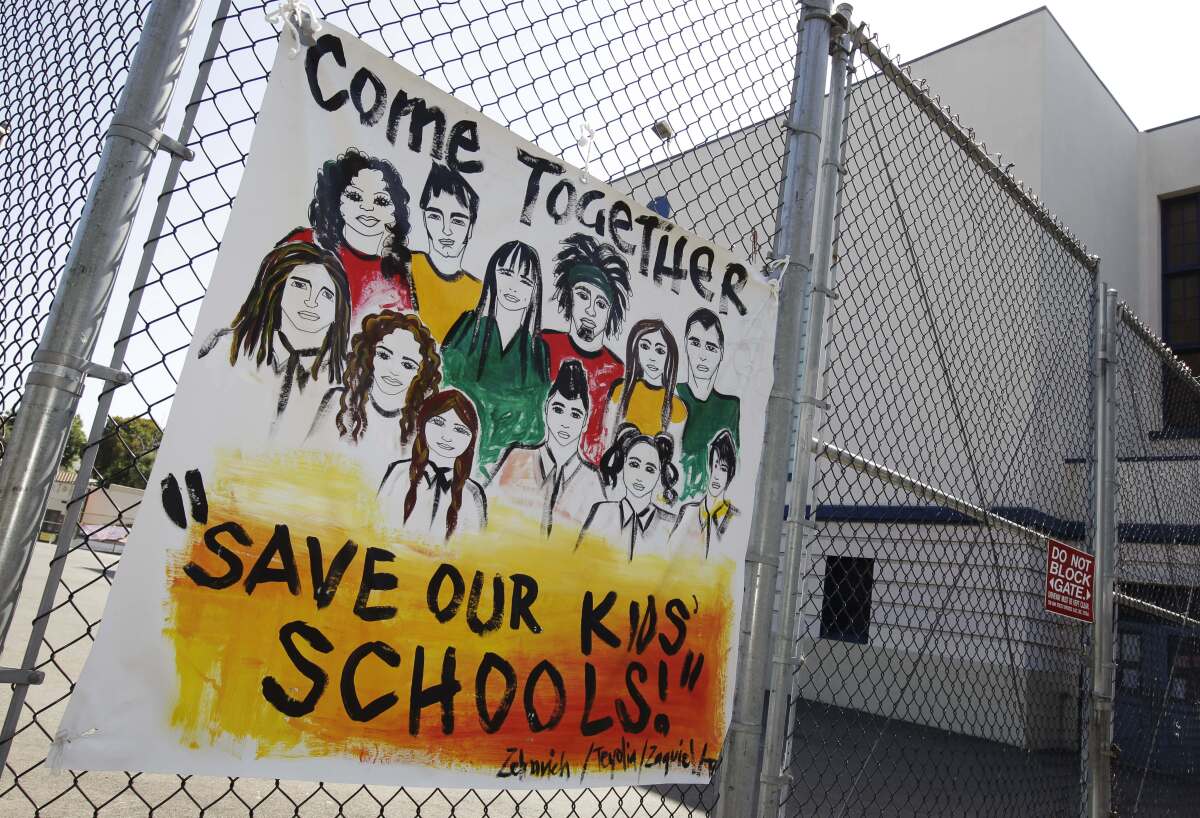Column: Oakland hunger strike is a harbinger of looming California school funding crisis

- Share via
In the birthplace of the Black Panthers, it’s best not to mess with Black and brown kids.
So when an Oakland Unified School Board of Education member leaked a list of proposed campus closures to the community in January — a list that included a beloved elementary campus that is the oldest school in Oakland and an anchor of the Black community — things went haywire fast.
While every school on the list had its supporters, the inclusion of Prescott Elementary, established in 1869, felt like a body blow to many. Just three years ago, the district celebrated the school’s sesquicentennial anniversary, honoring its location in a neighborhood with the second-largest Black population in the state, and one that had long been a destination for immigrants from China, Mexico and other countries.
Dr. Ida Louise Jackson, the daughter of a formerly enslaved man and one of the first certified Black teachers in the country, began teaching there in 1925. In 1933, it opened a “mixed” nursery, welcoming children of all races. Its principal, Enomiwoyi Booker, said in media coverage that the school was a “secret gem.”
The school board said Prescott needed to close, given the district’s declining enrollment and financial troubles. Protests, student walkouts and a hunger strike by two district employees at another targeted campus failed to sway enough board members to even slow the process for deciding which schools, if any, should be shuttered.
On Wednesday, after eight hours of angry public testimony, the board voted to remove Prescott from the list of schools being closed but move ahead with shuttering seven campuses and merging four others. It was too little, too late.
Oaklanders feel betrayed by their school district, regardless of Prescott’s reprieve. School board member Mike Hutchinson told his colleagues, right before the Zoom feed cut off, “You can take those Black Lives Matter signs off your lawn and shred them. ... You all just declared war on us.”
California is running low on kids, laying the groundwork for more emotional clashes like the one in Oakland. Schools get paid when kids show up. Fewer kids means less cash.
Declining enrollment projections in California schools have Gov. Gavin Newsom and legislators reconsidering the state’s decades-old funding formula.
Of course, that is an overly simplified shorthand for the local control funding formula — the nuanced, complicated, thoughtful and obscenely boring brainchild of former Gov. Jerry Brown. It was meant to give districts greater control over how they spend state money while also making public education more equitable by significantly padding the payments for low-income students, English-language learners and foster youth.
But what happened in Oakland should be a warning that, nearly a decade into the funding formula’s creation, it’s time for state leaders to tweak it and help avoid more last-minute, Oakland-like situations. Our public education system can’t be stagnant, but needs to continually adapt to what’s coming, not just what’s happening now.
Demographic changes and falling birth rates have led to a years-long tumble in the number of children in public schools, long before COVID-19. But the pandemic triggered a “precipitous drop” in attendance for 60% of California campuses, as Jonathan Kaplan, an education analyst with the California Budget & Policy Center, describes it. It was like we were running downhill, then ran off a cliff.
In the 2018-19 year leading up to the pandemic, California’s school enrollment declined by about 23,000 students, according to news outlet CalMatters. But between the 2019-20 and 2020-21 school years, enrollment plummeted by more than 160,000 students. L.A. Unified lost about 61,000 K-12 students since the 2018-19 school year, according to data obtained by my colleague Howard Blume.
Oakland has lost 15,000 students over the last decade, including more than 3,000 in the last three years — though its financial problems also stem from mismanagement and two state bailout loans that totaled $100 million and are still being repaid.

State Sen. Ben Allen, who was previously a member of the Santa Monica-Malibu Unified School District board, said he’s hearing from school administrators statewide who are worried about how volatile enrollment is going to hit their bottom line. Assemblymember Al Muratsuchi, who represents South Bay cities, said those fears have even spread to districts usually immune to budget crunches — places like Manhattan Beach, Hermosa Beach and Palos Verdes have all seen drops of about 10% since the pandemic began.
But dealing with that reality can’t involve the same-old, same-old of expecting poor communities of color to bear the brunt of shrinkage, just because years of neglect have left those schools struggling to survive already.
School closures don’t just shuffle kids around — they disrupt lives and communities, often vulnerable ones where a nudge in the wrong direction can have lasting consequence. For a parent working three jobs or a family struggling to find food, transporting a child to an unfamiliar school often farther away can be one problem too many. California leaders need to be thinking about how to protect places like Prescott Elementary now, before they wind up on the chopping block.
This would be the year to do it, because California is flush with extra state budget cash and Gov. Gavin Newsom has already suggested giving more than $1 billion toward education — a figure that includes a historic bump in per-pupil spending and a commitment to universal prekindergarten. But that means it’s also the year that we will likely lock in a policy path that will affect the next generation of students.
Much of the policy debate hinges on whether we should fund schools based on their enrollment (how many kids sign up to attend) or continue with the system of funding based on attendance — the average number of kids who show up. Most states use enrollment numbers, which generally provide schools with more money. California uses average daily attendance, in part to encourage schools to invest in getting kids into classrooms.
Kids in low-income areas are especially vulnerable to chronic absenteeism for a variety of reasons — from lack of access to healthcare to family situations. The debate now is whether average daily attendance funding helps those kids by making sure schools are invested in their attendance, or whether schools would do the right thing and pursue attendance even if we moved to enrollment funding.
California school districts may have to close some campuses as enrollments continue to decline. But they don’t have to take Oakland’s approach.
That’s the bigger issue Newsom and other elected leaders must be watching, to make sure solutions aren’t confined inside the vacuum of educational policy. How we fund schools should be part of a much larger debate about making it easy for families to get their kids to school every day, and providing the right supports to make that happen. Schools can’t be responsible for everything that happens in a student’s life, but they are one critical touchpoint for families.
That is especially true as we move from pandemic to endemic, letting our attention stray from the mental and physical health problems our children have weathered and will continue to cope with for many years. Those are realities only families and communities can speak to, not policymakers, and what school board conversations should be focused on now instead of masks and mandates.
Often with education funding, the debates look like a weedy swamp, and as a parent, I know it can feel daunting to wade in. But as Oakland shows, the alternative to being in the weeds is storming the streets, when the worst has already happened.
More to Read
Sign up for Essential California
The most important California stories and recommendations in your inbox every morning.
You may occasionally receive promotional content from the Los Angeles Times.













